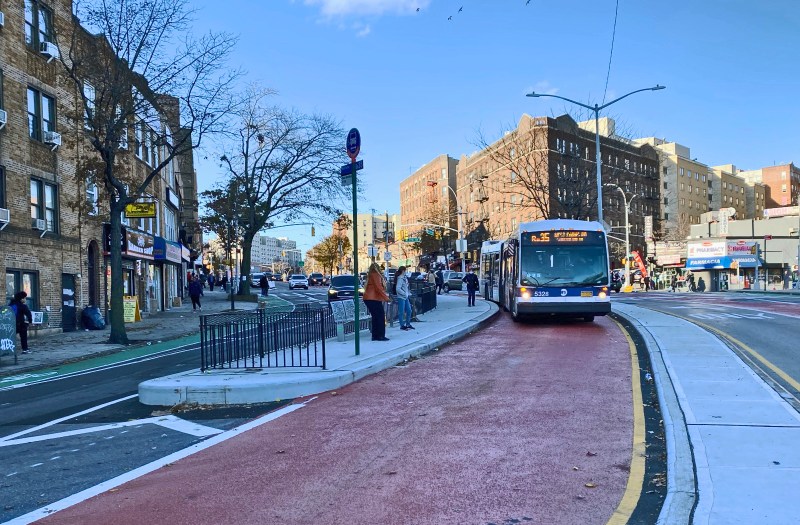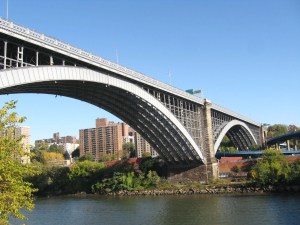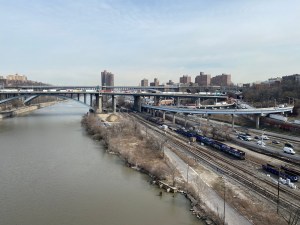THE BRONX IS UP: DOT Has Fixed A Dangerous Stretch in the Most Dangerous Borough

They’ve tamed the Highway.
Department of Transportation officials will formally cut the ribbon Friday on the agency’s complete transformation of the Edward L. Grant Highway in the Highbridge section of The Bronx from a multi-lane speedway that lived up to its name into a calmer, narrower roadway that’s been fitted with a protected bike lane and a dedicated, center-running bus lane.
“This is a major, transformative project,” Nivardo Lopez, the DOT’s Bronx commissioner, told Streetsblog in a sneak peak of the work to be unveiled at a presser on Friday. “It does what we would love to do on all streets — safe, separate modes of transportation.”
The changes are so major that they appear to be the result of a major capital project, involving millions of dollars and multiple subcontractors. But Lopez said the work — which includes pedestrian refuge islands, bus stop improvements along with the dedicated lane, the protected bike lane and signage — came in at far less because the work was done in-house. (Many bus lane or road redesign projects, such as the Grand Concourse nearby, require lots of work under the roadbed, but this project did not.)
The “before” and “after” shots below really demonstrate the importance of the project:

The work was long overdue. According to the DOT, at various times of the day, up to 71 percent of the users of the roadway, which runs between Jerome Avenue at the Cross Bronx Expressway, are in buses — but those passengers experience some of the slowest commutes in the borough, with bus speeds averaging 6.7 miles per hour in the morning and 5.7 miles per hour in the evening rush.
A center-running bus lane will help because the bus won’t have to go all the way to the right-hand curb and then work its way back into traffic. Passengers will board (or de-bus) on newly constructed islands that prioritize transit users, and also narrow the roadway to cut down on speeding.
“Center-running lanes are best practice, but here they really work because the buses exit the E.L. Grant Highway [either at Jerome Avenue in the southbound direction or to turn onto the Washington Bridge in the northbound direction] with a left turn,” said Nolan Levenson, senior project development in the transit development group, who said an earlier center-lane bus project on 161st Street from Yankee Stadium to the Bronx courthouse increased bus speeds by 40 percent.

The narrower roadway, and the protected bike lane, are expected to reduce crashes. Between 2013 and 2017, 219 people (15 cyclists, 28 pedestrians and 176 motorists) were injured in roughly 315 crashes on the .6-mile, S-shaped anomaly. Those numbers are certainly not worst in the borough, but are enough to make the roadway a “Vision Zero priority corridor,” Lopez said.
The redesign of Edward L. Grant Highway has certainly been on the DOT radar screen for a while. In 2014, the agency presented a plan [PDF] that improved conditions for pedestrians along just the one-block stretch between the Cross-Bronx Expressewer and Plimpton Avenue.
But the larger plan to calm traffic on the highway could not come at a better time. Cyclist injuries are up 44 percent this year in The Bronx, according to the NYPD, with 696 bike riders injured this year compared to 482 over the same period last year. No other NYPD command has experienced such a massive increase.
In addition to the rising bloodshed, Citi Bike has only just arrived in the last few weeks in that corner of the Highbridge section of The Bronx, with several docking stations along or adjacent to the highway. The Department of Transportation is eager to show a commitment to borough cyclists, given that The Bronx leads all boroughs for fatalities so far this year and has virtually no on-street protected bike lanes.
The roadway is named after the New York Giant third-baseman who did not achieve true renown until after he retired from baseball after a middling career in 1915. In 1917, he became one of the first people to enlist in the armed forces to fight in what was then called The Great War (given that historians could not imagine that there would shortly be another).
During a daring search-and-rescue mission to find the so-called “Lost Battalion” in the Argonne, Grant was killed on Oct. 5, 1918, the first professional baseball player to die in a war. In addition to the highway, he also was honored with a plaque in center field of the old Polo Grounds, which once stood on the other side of the Harlem River in Manhattan.
*whispers* busways busways
**chanting grows louder** Busways Busways
***shouting*** BUSWAYS BUSWAYS https://t.co/QPZ2Fn03gM
— Second Ave. Sagas (@2AvSagas) November 20, 2020


